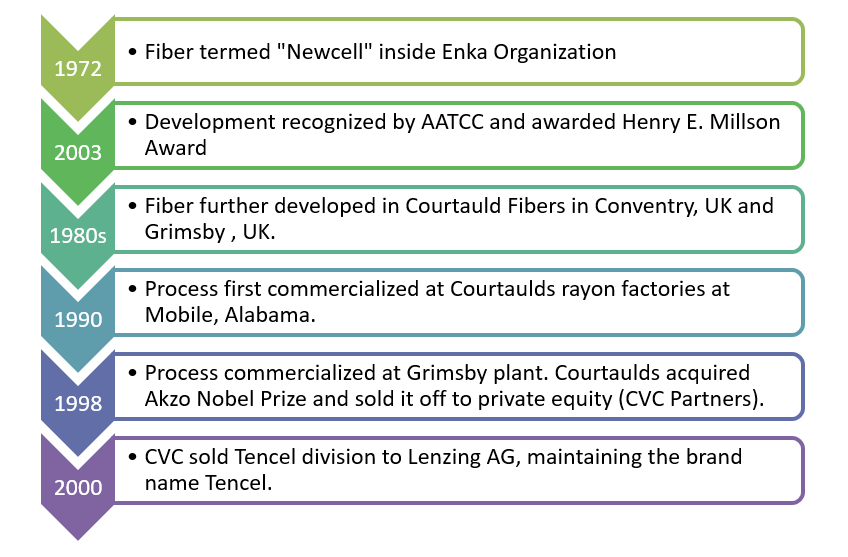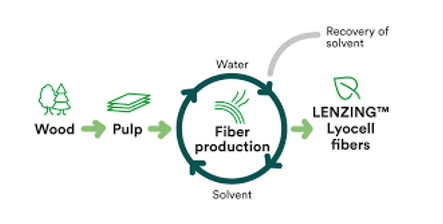This article is written by Snehal Gehi. She has recently completed her internship in a Linen yarn manufacturing company. She has written this article based on her research and learning from the linen yarn manufacturing company. In this article, she has covered the origin of lyocell fiber, its history, the manufacturing process of Tencel fiber, and its applications.

Here are a few figures to start with.
- 73% of clothing ends up in landfills.
- 1.5 trillion liters of water is used by the fashion industry each year.
- 20% of industrial water pollution comes from garment manufacturing.
Choosing the right fabric can change these figures.
We have been listening about many sustainable fibers; one of them is Tencel/Lyocell.
Origin of Tencel
An Austrian company namely, Lenzing AG, owns a brand called TENCEL.The term Tencel is actually a lyocell fiber (just like Xerox is for a copy). The Lenzing Group, having its roots in Austria, is working for more than 75 years. This innovative group produces viscose, modal, and lyocell (Tencel) fibers. This article mainly focuses on lyocell.
As the company's mission statement reads, “Nature is our origin. Innovation is our mission.", it stands by its producing top-quality and innovative fibers which can be used in apparel, home textiles, technical textiles, and non-wovens.
This global company has its factories in Germany, the Czech Republic, and the US which implement high environmental standards in all production processes. They mainly focus on careful utilization of resources, reduction of emissions, and systematic management of energy sources.
History of Tencel Fiber (and Fabric)
The production of this eco-friendly fiber began in the year 1972.How is Tencel different from lyocell?
There is a difference between Tencel branded lyocell by Lenzing and other general lyocell. The general lyocell is made from the wood pulp of oak and birch trees (sometimes bamboo too) which is eco-friendly and sustainable.However, Tencel happens to be more environment-friendly as it is made from eucalyptus wood that is harvested from natural forests. These trees require very less water, no toxic pesticides and they grow fast. This committed company does not compromise with wood sourcing and only produces fabric from the forests with certification.
According to Lenzing AG, they “can grow enough trees for a ton of Tencel on half an acre of forestland that is unsuitable for farming.”
Related post: Is viscose a sustainable fiber?
Tencel: A Regenerated Fiber
Tencel (or any form of Rayon) is neither a natural fiber like silk, neither a synthetic fiber like polyester. It's something in between; a synthetic fiber with natural origins also called a regenerated cellulose fiber.Tencel fiber manufacturing process
The key ingredient for general lyocell is wood from trees mainly birch and oak, whereas Tencel is manufactured using naturally grown trees of Eucalyptus wood, which do not require any pesticides and thrive on very little water. As the company, Lenzing AG claims, these forests and pulp produced for Tencel have achieved FSC Certification (Forest Stewardship Council) along with The European Programme for the Endorsement of Forest Certification which has endorsed Tencel's farming practices as sustainable. The company has replaced the traditional and polluting fiber processing method with its eco-friendly and sustainable technologies. Let us have a detailed understanding of the process:1. Chipping the wood
Lenzing sources their wood pulp for Tencel from ‘natural forests’ in Canada, U.S., Austria, Germany, Czech Republic, Hungary, France, Belgium, Ukraine, Switzerland, Slovenia, Slovakia, Belarus, Russia, South Africa, China, and Indonesia. These trees are harvested by loggers and cut into logs of roughly about 20 feet. It is necessary to de-bark these logs which can be done with high-pressure jets of water. These logs are then fed in a chipper with cuts into small squares.2. Preparing the wood pulp
The wood chips are loaded in a vat of chemical digesters that softens them into wet pulp. The pulp is dried and rolled onto spools. The spools can weigh up to as heavy as 227-230 kg.3. Dissolving the Cellulose
The dried sheets of pulp are broken down into small squares. These chips are turned into pulp that is broken down with amine oxide, a non-toxic solvent that heats the wood pulp until all of its cellulose dissolves.4. Filtering
Once all the cellulose is dissolved into a clear solution, the pulp is filtered to ensure that everything is dissolved.5. Spinning
This solution is pumped through spinnerets (just like a showerhead), and the cellulose is passed through it which forms a long strand of fiber. It is immersed in another solution of amine oxide which sets the fiber strands. Later, they are rinsed clean with water.6. Drying and Finishing
These long strands of fiber are dried to evaporate water from it. At this point, a lubricant is applied (soap, silicone, or other agents) to detangle them which makes the process of carding and spinning easier.7. Final Steps
These long fiber strands are taken to a crimper, a machine that compresses the fiber, giving it texture and bulk. Later, it is carded, combed, and separated from other strands. The continuous-length strands are cut and baled for shipment to a fabric mill.The entire manufacturing process, from unrolling the raw cellulose to baling the fiber, takes only about two hours.
The closed-loop process
Closed-loop processes are very difficult to achieve. They mainly aim to reuse, recover and recycle as much as possible. In the process of manufacturing Tencel, 99% of the chemical solvent is recovered back in the system reducing waste and emissions. The by-product of the process is converted into biofuel for renewable energy, making sure nothing goes to waste. Also, the amine oxide used twice in the process does not cause any harm to humans. In fact, flax leads by 20% in less water consumption, but the closed-loop system of Tencel makes it even worthier in terms of conservation.
Properties of Tencel fiber
The quality, performance, and versatility of Tencel make it stand out among all other fibers. It has unique physical properties and due to its environment-friendly nature, it is always a great choice in textiles, apparel, non-wovens, etc. Let us have a look at its properties:
Other properties of Tencel fiber:
- Tencel has excellent absorbency, is softer than silk, and cooler than linen.
- Tencel readily absorbs moisture and quickly releases it.
- Tencel is very gentle to the skin and we see its application in home textiles.
- The growth of bacteria on Tencel fibers is extremely low as compared to synthetic fibers and cotton.
- Tencel fibers can be dyed readily.
- Tencel fabrics have the good abrasion resistance and dimensional stability.
- As wool can get attacked by moths, Tencel doesn’t.
- Tencel fabrics are wrinkle-resistant.
- Tencel fabrics have excellent fall.
Physical Structure:
- Tencel has a rounded cross-section and smoother longitudinal appearance.
- The structure of Tencel is homogeneous in nature and dense.
Pros of Tencel made fabrics and products:
- Compared to cotton, consumers often say Lyocell fibers feel softer, and "airier", due to its better ability to wick moisture.
- It has good absorbency.
- Lyocell is strong in wet as well as dry conditions.
- It is resistant to wrinkling.
- Fabric made of Tencel lyocell has excellent drape.
- It is easy to mix with cotton/silk.
- The production of lyocell is sustainable.
Cons of Tencel made fabrics and products:
- It has a tendency to pill.
- It is susceptible to mildew.
- It is expensive than other fabrics.
Application of Tencel Fabrics
Tencel is a diverse fabric. The nature of Tencel is versatile and can be combined with a variety of fibers like cotton, polyester, acrylic, silk, etc. to fulfill various needs like functionality, aesthetics, appearance, and comfort. Tencel is not only a part of the apparel industry but also technical textiles and non-wovens.- As a substitute for cotton and silk - Used to make dresses, shirts, towels, and underwear.
- For commercial purposes - Used for Conveyor belts as lyocell is resistant to wear and tear.
- For medical applications -Used in medical dressings
- As a component for specialty papers - Used as a filtration material
Denim from a Sustainability Mindset:
Lenzing AG has expanded its collection collaborating with various brands and this time it was to introduce a sustainable denim wardrobe. This collaboration with Munich Fabric Starts where they first showcased their range of denim which mainly centered on environmentally conscious production and influence the denim supply chain for better products.Eco-brand collaborations:
Various eco-friendly brands like TAMGA Designs, Amour Vert, Patagonia, Eileen Fisher, etc. have collaborated with Lenzing AG for the brand Tencel to create some amazing pieces with classic designs and thoughtful tailoring which are simple yet versatile. With romantic prints, feminine silhouettes and relaxed fit, you name it, these brands have it all. Tencel is no less than any other fabric and is now replacing silk and cotton.Tencel’s initiative of Nature in your Home
Tencel claims that their fibers produced by microtechnology gently envelope your body and improve the quality of sleep. The bed linen, bed mattresses, and filled products made of Tencel have a silky hand feel and natural sheen.Apart from bedding, towels made from Tencel remain soft over time and withstand repeated wash and dry cycles. Tencel also has a range of interiors like carpets and upholstery which keep the living space comfortable.
Tencel: Healthcare textiles
Healthcare textiles are of various types from bed linens, surgical gowns, surgical covers, etc. Tencel has proved to be an ideal choice for the medical industry due to its high absorbency and anti-bacterial properties.Tencel: Air filter Material
Air filter material made of Tencel fiber can increase the benefits of the product. The manufacturing method of the air filter material with the Tencel fiber has fewer steps, lower manufacturing costs, and strong practicability.Application of Tencel in Indian origin Brands:
Anita Dongre showcased a collection using Tencel, in the edition of Lakme Fashion Week on January 30, 2019. She had used this textile to create a collection that celebrates summer with floral prints, light and flowing silhouettes, and bright colors. The garments were designed for summer destination weddings and resort wear.Renowned Indian designer Rajesh Kumar Singh also collaborated with Lenzing AG and showcased his work in Lakme Fashion Week 2018 winter edition.
The designer used a variety of TENCEL yarns and fabrics for his collection 'Welcome to the Jungle TENCEL 2.0' and incorporated iconic Indian crafts such as Chanderi, Benarasi, Jamdani, hand-block prints, and more.
The designer used a variety of TENCEL yarns and fabrics for his collection 'Welcome to the Jungle TENCEL 2.0' and incorporated iconic Indian crafts such as Chanderi, Benarasi, Jamdani, hand-block prints, and more.
References:
https://www.goodhousekeeping.com/clothing/a27560140/what-is-tencel-fabric/
https://www.euronews.com/living/2019/06/15/what-is-tencel-the-sustainable-fabric-everyone-is-talking-about
https://oliveandcrate.com/blogs/olive-crate-journal/why-tencel-is-better-for-the-environment-than-cotton-and-linen
https://www.thr3efold.com/news/why-is-tencel-the-new-hot-sustainable-fabric
http://www.madehow.com/Volume-5/Lyocell.html
https://en.wikipedia.org/wiki/Lyocell
https://www.business-standard.com/article/pti-stories/rajesh-pratap-singh-to-create-his-first-ethnic-collection-using-tencel-fibres-118080400202_1.html
About the author
Snehal Gehi is pursuing her Bachelor of Fashion Technology from NIFT.


